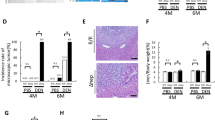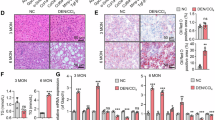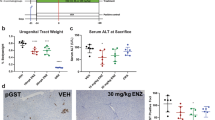Abstract
The present study was designed to investigate the effect of Fas-mediated liver cell apoptosis, induced by a hamster monoclonal antibody against mouse Fas antigen, on diethylnitrosamine (DEN)-induced hepatocarcinogenesis in mice. DEN (10 μg g–1, intraperitoneally (i.p.)) was given to 15-day-old male C3H/HeJ mice. Three weeks after DEN treatment, Fas-mediated liver cell apoptosis induced by anti-Fas antibody resulted in a biphasic effect on induction of liver cell tumours, depending on dosage and time of antibody administration. Single or multiple treatment with high dose anti-Fas antibody (5 μg animal–1), induced gross liver cell damage and decreased the incidence of liver cell tumours in DEN-treated mice. In contrast, five treatments with low dose anti-Fas antibody (2 μg animal–1), induced dispersed localized liver cell damage and promoted the number of large-sized liver cell adenomas and hepatocellular carcinomas. These findings suggest that high dose anti-Fas antibody has a marked effect on the clearance of DEN-initiated liver cells, whereas repeated administration of low dose anti-Fas antibody promotes hepatocarcinogenesis. It is concluded that Fas-mediated liver cell apoptosis has a biphasic effect on hepatocarcinogenesis. © 2000 Cancer Research Campaign
Similar content being viewed by others
Article PDF
Change history
16 November 2011
This paper was modified 12 months after initial publication to switch to Creative Commons licence terms, as noted at publication
References
Ando K, Hiroishi K, Kaneko T, Moriyama T, Muto Y, Kayagaki N, Yagita H, Okumura K and Imawari M (1997) Perforin, Fas/Fas ligand, and TNF-alpha pathways as specific and bystander killing mechanisms of hepatitis C virus-specific human CTL. J Immunol 158: 5283–5291
Columbano A, Endoh T, Denda A, Noguchi O, Nakae D, Hasegawa K, Ledda-Columbano GM, Zedda AI and Konishi Y (1996) Effects of cell proliferation and cell death (apoptosis and necrosis) on the early stages of rat hepatocarcinogenesis. Carcinogenesis 17: 395–400
Dragani TA, Manenti G and Della Porta G (1986) Enhancing effects of carbon tetrachloride in mouse hepatocarcinogenesis. Cancer Lett 31: 171–179
Dusheiko GM (1990) Hepatocellular carcinoma associated with chronic viral hepatitis. Aetiology, diagnosis and treatment. Br Med Bull 46: 492–511
Frith CH and Ward JM (1979) A morphologic classification of proliferative and neoplastic hepatic lesions in mice. J Environmen Pathol Toxicol 3: 329–351
Gavrieli Y, Sherman Y and Ben-Sasson SA (1992) Identification of programmed cell death in situ via specific labeling of nuclear DNA fragmentation. J Cell Biol 119: 493–501
Hara A, Yoshimi N, Hirose Y, Ino N, Tanaka T and Mori H (1995 a) DNA fragmentation in granular cells of human cerebellum following global ischemia. Brain Res 697: 247–250
Hara A, Yoshimi N, Mori H, Iwai T, Sakai N, Yamada H and Niwa M (1995 b) Hypothermic prevention of nuclear DNA fragmentation in gerbil hippocampus following transient forebrain ischemia. Neurol Res 17: 461–464
Hayashi N and Mita E (1997) Fas system and apoptosis in viral hepatitis. J Gastroenterol Hepatol 12: S223–226
Higaki K, Yano H and Kojiro M (1996) Fas antigen expression and its relationship with apoptosis in human hepatocellular carcinoma and noncancerous tissues. Am J Pathol 149: 429–437
Hiramatsu N, Hayashi N, Katayama K, Mochizuki K, Kawanishi Y, Kasahara A, Fusamoto H and Kamada T (1994) Immunohistochemical detection of Fas antigen in liver tissue of patients with chronic hepatitis C. Hepatology 19: 1354–1359
Jiang Z, Liu Y, Savas L, Smith L, Bonkovsky H, Baker S and Banner B (1997) Frequency and distribution of DNA fragmentation as a marker of cell death in chronic liver diseases. Virchows Arch 431: 189–194
Klaunig JE, Weghorst CM and Pereira MA (1987) Effect of the age of B6C3F1 mice on phenobarbital promotion of diethylnitrosamine-initiated liver tumors. Toxicol Appl Pharmacol 90: 79–85
Leithauser F, Dhein J, Mechtersheimer G, Koretz K, Bruderlein S, Henne C, Schmidt A, Debatin KM, Krammer PH and Moller P (1993) Constitutive and induced expression of APO-1, a new member of the nerve growth factor/tumor necrosis factor receptor superfamily, in normal and neoplastic cells. Lab Invest 69: 415–429
Lindroos PM, Zarnegar R and Michalopoulos GK (1991) Hepatocyte growth factor (hepatopoietin A) rapidly increases in plasma before DNA synthesis and liver regeneration stimulated by partial hepatectomy and carbon tetrachloride administration. Hepatology 13: 743–750
Lipsky MM, Hinton DE, Klaunig JE and Trump BF (1981) Biology of hepatocellular neoplasia in the mouse. III. Electron microscopy of safrole-induced hepatocellular adenomas and hepatocellular carcinomas. J Natl Cancer Inst 67: 393–405
Matsuda Y, Amuro Y, Higashino K, Hada T, Yamamoto T, Fujikura M, Yamaguchi K, Shimomura S, Iijima H and Nakano T (1995) Relation between markers for viral hepatitis and clinical features of Japanese patients with hepatocellular carcinoma: possible role of alcohol in promoting carcinogenesis. Hepato-Gastroenterol 42: 151–154
Mita E, Hayashi N, Iio S, Takehara T, Hijioka T, Kasahara A, Fusamoto H and Kamada T (1994) Role of Fas ligand in apoptosis induced by hepatitis C virus infection. Biochem Biophys Res Com 204: 468–474
Mochizuki K, Hayashi N, Hiramatsu N, Katayama K, Kawanishi Y, Kasahara A, Fusamoto H and Kamada T (1996) Fas antigen expression in liver tissues of patients with chronic hepatitis B. J Hepatol 24: 1–7
Natoli G, Ianni A, Costanzo A, De Petrillo G, Ilari I, Chirillo P, Balsano C and Levrero M (1995) Resistance to Fas-mediated apoptosis in human hepatoma cells. Oncogene 11: 1157–1164
Nishimura Y, Hirabayashi Y, Matsuzaki Y, Musette P, Ishii A, Nakauchi H, Inoue T and Yonehara S (1997) In vivo analysis of Fas antigen-mediated apoptosis: effects of agonistic anti-mouse Fas mAb on thymus, spleen and liver. Int Immunol 9: 307–316
Ogasawara J, Watanabe-Fukunaga R, Adachi M, Matsuzawa A, Kasugai T, Kitamura Y, Itoh N, Suda T and Nagata S (1993) Lethal effect of the anti-Fas antibody in mice. Nature 364: 806–809
Okazaki M, Hino K, Fujii K, Kobayashi N and Okita K (1996) Hepatic Fas antigen expression before and after interferon therapy in patients with chronic hepatitis C. Digest Dis Sci 41: 2453–2458
Pound AW and McGuire LJ (1978 a) Repeated partial hepatectomy as a promoting stimulus for carcinogenic response of liver to nitrosamines in rats. Br J Cancer 37: 585–594
Pound AW and McGuire LJ (1978 b) Influence of repeated liver regeneration on hepatic carcinogenesis by diethylnitrosamine in mice. Br J Cancer 37: 595–602
Rouquet N, Allemand I, Molina T, Bennoun M, Briand P and Joulin V (1995) Fas-dependent apoptosis is impaired by SV40 T-antigen in transgenic liver. Oncogene 11: 1061–1067
Saile B, Knittel T, Matthes N, Schott P and Ramadori G (1997) CD95/CD95L-mediated apoptosis of the hepatic stellate cell. A mechanism terminating uncontrolled hepatic stellate cell proliferation during hepatic tissue repair. Am J Pathol 151: 1265–1272
Smith CA, Farrah T and Goodwin RG (1994) The TNF receptor superfamily of cellular and viral proteins: activation, costimulation, and death. Cell 76: 959–962
Watanabe-Fukunaga R, Brannan CI, Itoh N, Yonehara S, Copeland NG, Jenkins NA and Nagata S (1992) The cDNA structure, expression, and chromosomal assignment of the mouse Fas antigen. J Immunol 148: 1274–1279
Author information
Authors and Affiliations
Rights and permissions
From twelve months after its original publication, this work is licensed under the Creative Commons Attribution-NonCommercial-Share Alike 3.0 Unported License. To view a copy of this license, visit http://creativecommons.org/licenses/by-nc-sa/3.0/
About this article
Cite this article
Hara, A., Yoshimi, N., Yamada, Y. et al. Effects of Fas-mediated liver cell apoptosis on diethylnitrosamine-induced hepatocarcinogenesis in mice. Br J Cancer 82, 467–471 (2000). https://doi.org/10.1054/bjoc.1999.0944
Received:
Revised:
Accepted:
Published:
Issue date:
DOI: https://doi.org/10.1054/bjoc.1999.0944



